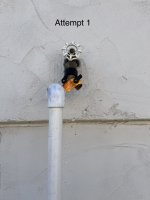Hello!  I’d appreciate your advice on whether our autofill line is plumbed correctly. Attached are pictures showing the plumber’s 3 attempts.
I’d appreciate your advice on whether our autofill line is plumbed correctly. Attached are pictures showing the plumber’s 3 attempts.
Attempt 1: The plumber used a hose bibb splitter and connected the autofill. The autofill had been working for several weeks, but the other side of the splitter started leaking.
Attempt 2: He plumbed the autofill directly to the water line coming from the house and then used a T connector to attach the hose bibb. However, the splitter on the hose bibb was still leaking on the same side. I’m not sure why he didn’t just replace the hose bibb splitter to begin with.
Attempt 3: He replaced the hose bibb.
We’d like the ability to manually turn off the autofill and also have the ability to use the hose bibb for other gardening needs, so we liked how it was plumbed originally. It doesn’t look like we have that capability now (unless the black valve would let us do that). Is there anything else wrong with how it is plumbed now? Do I need to be concerned about what kind of metal the new T connector is made of (lead, etc.)?
Thank you very much in advance!
Attempt 1: The plumber used a hose bibb splitter and connected the autofill. The autofill had been working for several weeks, but the other side of the splitter started leaking.
Attempt 2: He plumbed the autofill directly to the water line coming from the house and then used a T connector to attach the hose bibb. However, the splitter on the hose bibb was still leaking on the same side. I’m not sure why he didn’t just replace the hose bibb splitter to begin with.
Attempt 3: He replaced the hose bibb.
We’d like the ability to manually turn off the autofill and also have the ability to use the hose bibb for other gardening needs, so we liked how it was plumbed originally. It doesn’t look like we have that capability now (unless the black valve would let us do that). Is there anything else wrong with how it is plumbed now? Do I need to be concerned about what kind of metal the new T connector is made of (lead, etc.)?
Thank you very much in advance!







